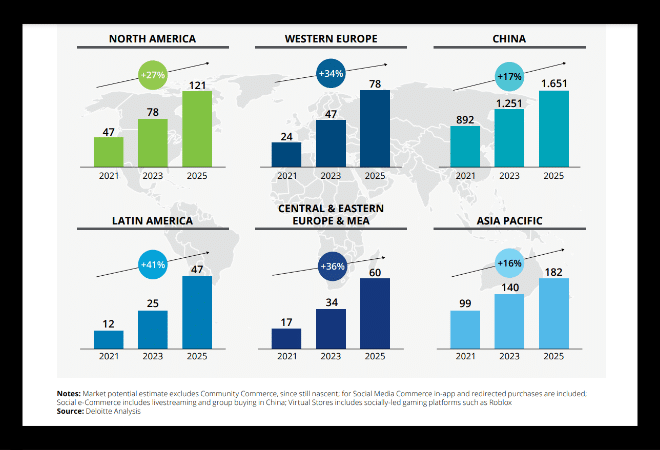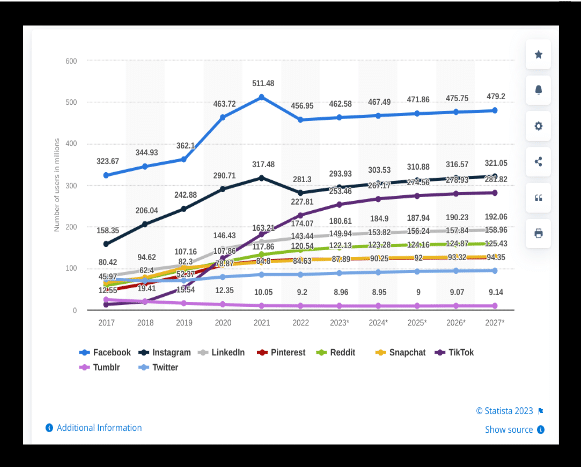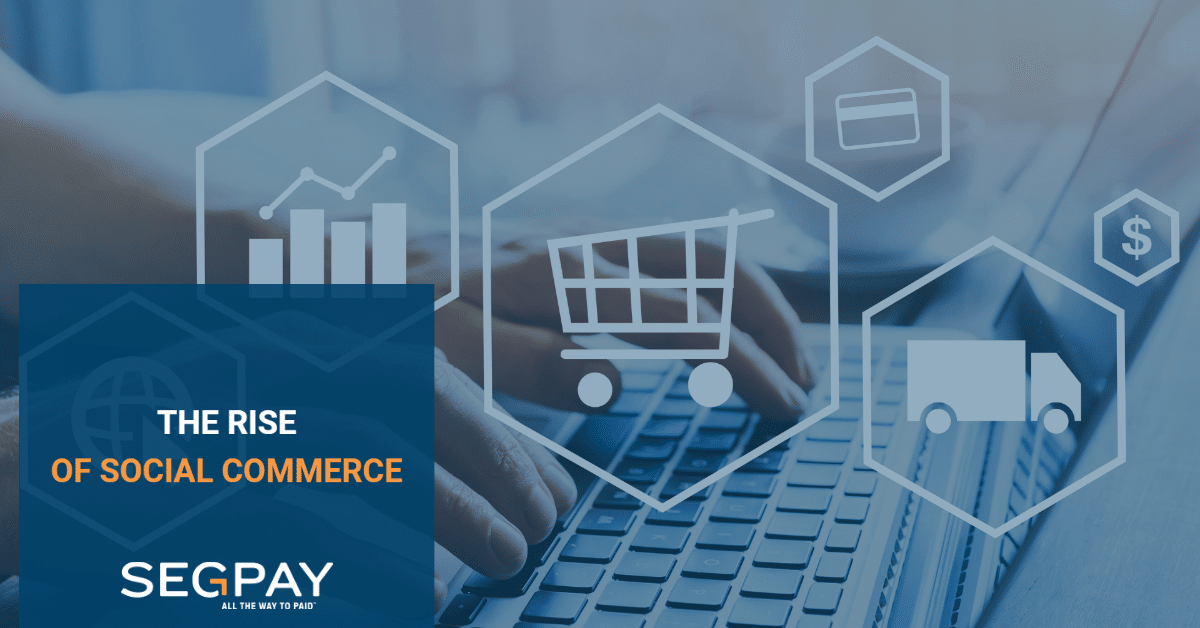- 5 minute read
Social commerce refers to a growing branch of e-commerce where goods and services are promoted and sold on social media platforms. In 2022, roughly 4.6 billion people (58% of the population) have spent more than two hours a day on social media channels.
The APAC region has been a Social Commerce trendsetter. According to New York-based Reprise Commerce, a quarter of shoppers in the APAC region have used live streaming while shopping online, and one-third explored Virtual Reality (VR) shopping. Half of the region’s e-shoppers are familiar with the Metaverse, a trend that we will explore in greater detail in the future. Asian shoppers are leading the way, surfing, comparing prices, and shopping on social media channels.

The social commerce industry in Europe is expected to grow steadily over the forecast period, recording a 36% CAGR (2022-2028). This booming trend was bound to spill over from Asia into Europe and the US in this global, interconnected world. Last February 2023, Research and Markets published a Report: “The Europe Social Commerce Market Intelligence and Future Growth Dynamics Databook.”
Deloitte recently published an in-depth Social Commerce Report, which explores the rise of social commerce. Europe and Latin America have the highest social commerce CAGR (2021 – 2025). This shouldn’t come as a surprise if one considers that social commerce has matured in Asia while this trend is emerging in other regions.

Social Commerce combines the pleasure of socializing with the kick of shopping. Merchants are discovering the tremendous potential of Social e-Commerce and have started including this in their omnichannel sales strategy to reach an international audience. Products and services are sold directly on social media platforms (e.g., Facebook, Instagram, Pinterest, TikTok, WeChat, etc.). Social media platforms allow merchants to create brand awareness by interacting with specific target groups. This strategy may include Live commerce, where influencers show their products during Live streaming, and customers are ‘seduced’ into buying products and services via Buy links or QR Codes through a mix of commercial and social entertainment, which appeals to younger generations.
Social Commerce Comes in Different Flavors
In its report, Deloitte identifies eight key social commerce features:
- Digital Store
- Example: Clinique leverages Instagram check-out to allow users to shop for items directly on the platform.
- Livestream Commerce
- Walmart launched its own livestreaming platform to have influencers promote new products in an interactive setting.
- Conversational Commerce
- The Lego Group launched the chatbot ‘Ralph’ on Messenger to help shoppers purchase the right gift.
- Influencer Commerce
- Haagen-Dazs and TAKUMI partnered with influencers to create content on Instagram and TikTok to drive sales on Amazon Prime Now.
- AR Commerce
- Puma partnered with Snapchat to launch AR lenses that allowed users to try on branded sneakers and tracksuits with the possibility of purchasing them.
- Gaming Commerce
- Forever21 launched Shop City on Roblox, where users can set up their stores and sell the brand’s fashion products, including 3D showrooms.
- Group Buying
- Pinduoduo in China offers discounts to consumers when they buy in groups.
- Mini Programs
- WeChat mini-programs can offer product catalogues to enable consumers to discover, learn, and purchase products.
Retailers are investing in sales & marketing campaigns through social media channels. This is especially true in the fashion & beauty industry, where paid influencers, pop stars, and other VIPs help to advertise and promote their luxury products. Fashion brands deliver a livestreamed interactive shopping experience for their exclusive target group. Examples of this social commerce sales strategy are L’Oreal UK and Ireland partnering with TikTok to enable its customers in the United Kingdom to buy products from its beauty brands Garnier and NYX Professional Make-Up products through the TikTok app.
Most Popular Social Media Platforms in Europe
Merchants that want to reach out to a European audience will have to understand the preferred platforms of their target groups in different European countries.

According to Statista, Facebook remains Europe’s leading social media platform regarding user numbers, with approximately 457 million active users. Instagram follows, with around 281 million users in the region. However, if we have a closer look at the numbers above, we notice the growing popularity of China’s TicToc, which attracted over 174 Million European users within five years. Even though Facebook is leading in terms of users, Instagram triggered twice the amount of purchase intent (PI) compared with Facebook.
More than 80% of Germany’s population visits social media platforms. Shopify has enabled merchants on its marketplace to sell their products on Pinterest since 2021. Shopify and Pinterest have extended their partnership in 26 more countries, including Australia, Brazil, and the United Kingdom. The UK has 57.1 million active social media users, over half active on Facebook. In France’s fashion & perfumes hub, 50 million people are active on social media. Fashion retailers organize live shopping events to attract consumers’ attention through social media. According to Statista, Facebook and Instagram are Italy’s most popular social media platforms, followed by Telegram, TikTok, and Pinterest. Spain is one of the biggest social media markets in Western Europe. Home to more than 40 million social networking users in 2022, which is expected to grow to 5 million by 2027.
What Products do People Buy on Social Media Platforms?
According to the 2022 Research and Markets forecast, the following product categories will represent the largest market size in the European Social Commerce Industry Market Size between 2019-2028:
- Fashion & Footwear
- Beauty and Personal Care
- Food & Grocery
- Appliances and Electronics
- Home Improvement
Europeans pay for the products and services they buy on social media platforms with Credit and Debit Cards, Bank Transfers, Prepaid Cards, Digital Wallets, and Local Payment Methods.
What Motivates Consumers to Shop and Buy on Social Media Platforms?
Deloitte identifies five major social commerce drivers.
- Shoppers discover brands, products, and services via social media platforms.
- Gen Z shoppers discover products and services trending in their social circle.
- Shoppers are persuaded to buy products or services by watching influencers with millions of followers.
- Shoppers are persuaded to buy products because they engage in emerging new shopping experiences (e.g., livestreaming or Augmented Reality AR).
- Shoppers explore brands and products in the Metaverse.
Before merchants invest in social commerce to promote their brand and sell their products and services, they’ll first have to study the social media behavior of their target groups. Understand the type of content they interact with. Discover what triggers your key audience.
Once you have a clear picture of the social media platforms visited by your target groups, you can form partnerships and create specific content to build brand awareness in sync with your market strategy. What are the preferred payment methods of your target audience, and what is the best payment services provider that enables you to offer your target audience a frictionless payment experience?
Want to learn more about The Rise of Social Commerce?
If you want to know how Segpay can help you to reach out to a wider audience, do not hesitate to get in touch with one of our experts.
*******
This article has been written by @SandeCopywriter on behalf of Segpay Europe



